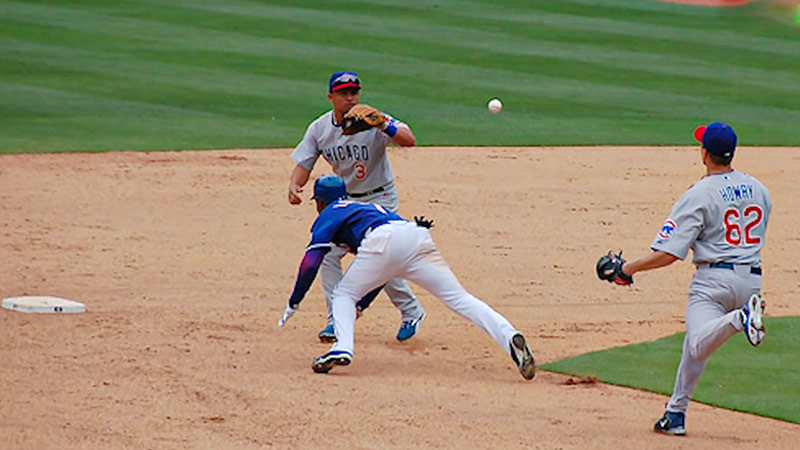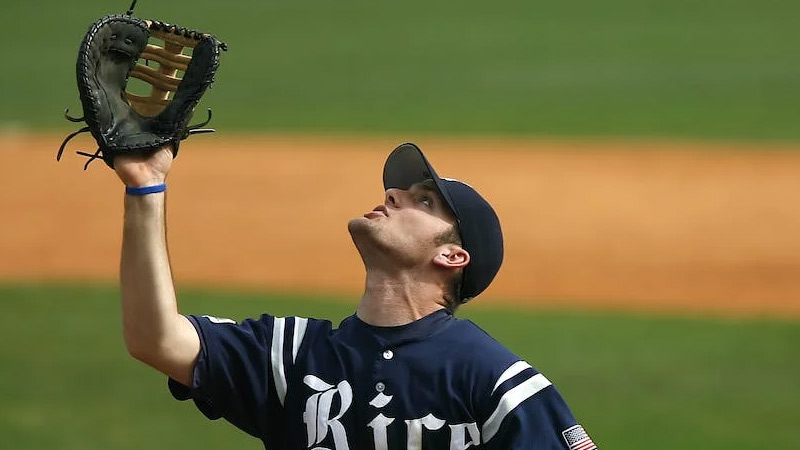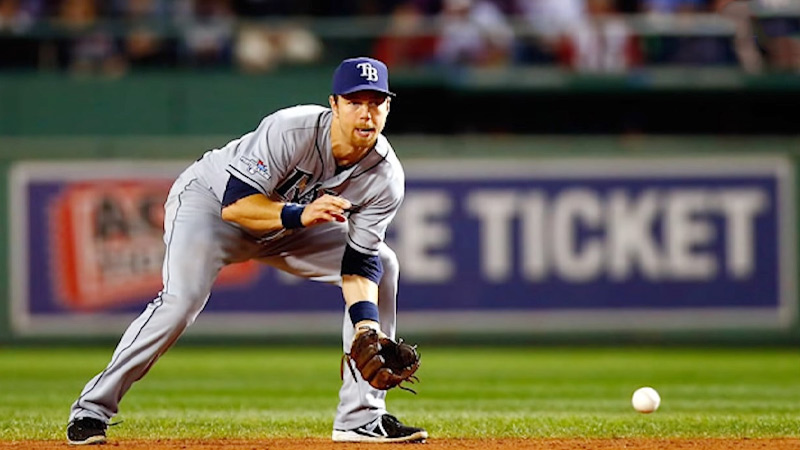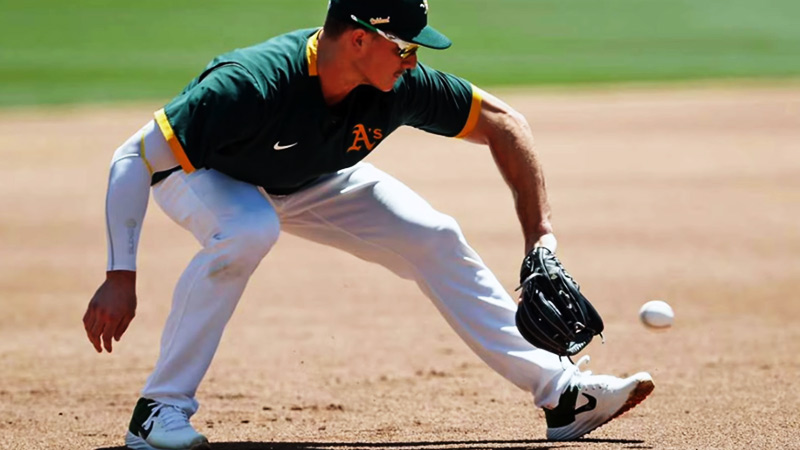In the world of Major League Baseball (MLB), every piece of equipment serves a purpose, and when it comes to gloves, size matters.
The choice of glove size for MLB infielders is a critical decision, as it directly impacts their performance on the field.
In this blog post, we’ll delve into what size glove MLB infielders use, exploring the factors that influence glove size and the reasons why these athletes opt for specific dimensions.
From shortstops to first basemen, each infield position demands a unique approach to glove selection, ensuring optimal control, quick ball transfer, and impeccable fielding skills.
We’ll uncover the secrets behind their choices, looking at how personal preferences, playing style, and league regulations converge to shape the perfect glove for these elite athletes.
So, if you’ve ever wondered about the glove that turns double plays and snags line drives, read on to uncover the secrets behind the ideal glove size for MLB infielders. Stay focused.
What Size Glove Do MLB Infielders Use?
Before you choose a pair for yourself, you should learn what size glove do infielders use. MLB infielders typically use gloves with a size ranging from 11.25 to 11.75 inches.
However, the choice of glove size is a matter of personal preference and can vary depending on the player’s position and playing style.
Infielders often prefer smaller gloves for better control and quick transfers when fielding ground balls, while some may opt for slightly larger gloves for added reach.
The choice of glove size is a balance between comfort and functionality, tailored to the specific needs and preferences of each player.
The Basics of MLB Infield Glove
Some of the basics of MLB infield gloves are mentioned in the following section;
Size and Webbing

MLB infield gloves are typically smaller than outfield gloves, with a size range of 11.25 to 11.75 inches. Infielders often prefer gloves with shallower pockets and tighter webs to ensure quick ball transfer and control.
A common web style for infielders is the I-Web or H-Web, as they allow for a clear view of the ball when fielding grounders.
Material and Construction
Infield gloves are made from high-quality leather, with some players favoring top-grain or full-grain leather for durability and a quick break-in period.
The construction of these gloves is designed to be sturdy and responsive, featuring reinforced fingers and palm padding to handle the impact of hard-hit balls.
Hand Orientation
Infield gloves are available in both right-hand throw (RHT) and left-hand throw (LHT) configurations, depending on the player’s dominant hand.
Middle infielders, like shortstops and second basemen, often use gloves with a shallower pocket for quicker ball transfer, while corner infielders, such as first and third basemen, may opt for a slightly larger glove with a deeper pocket to secure throws from across the diamond.
Player Customization
MLB infielders frequently customize their gloves to their specific preferences. This can include modifying the shape of the pocket, adding extra padding, or adjusting the wrist closure for a snug fit.
The aim is to create a glove that maximizes fielding efficiency and comfort while adhering to league regulations.
How to Measure MLB Infield Glove Size?
Measuring the correct size for an MLB infield glove is essential to ensure a comfortable and effective fit. Here’s how to do it:
Glove Size Chart
Check the manufacturer’s glove size chart for their specific recommendations. Each brand may have slight variations in sizing, so it’s a good starting point.
These charts often include hand circumference measurements to help you determine your size.
Hand Circumference
Measure your dominant hand’s circumference just above the knuckles using a flexible tape measure.
Make sure the tape is snug but not too tight. This measurement is usually in inches. Note that most gloves are available in even sizes (e.g., 11, 11.5, 12 inches).
Position-Specific Consideration
Consider your playing position when selecting a glove size. Infielders typically use smaller gloves, ranging from 11.25 to 11.75 inches, for better control and quick ball transfer.
Middle infielders might opt for the smaller end of this range, while corner infielders might prefer the larger end.
Try It On
Whenever possible, try on the glove you’re interested in before making a purchase.
Slide your hand into the glove and ensure it feels snug but not overly tight. Pay attention to how well your fingers reach the glove’s fingertips and how it wraps around your hand.
Consider Personal Preference

Ultimately, the right glove size also depends on your personal preference and comfort.
Some players may choose a slightly smaller or larger size based on how they like the feel of the glove and how it helps them field and control the ball effectively.
It’s important to balance the manufacturer’s recommendations with your own playing style and comfort.
Remember that properly fitting gloves are crucial for performance and preventing hand discomfort or injuries.
MLB outfielder Glove Size Vs. Infield Baseball Glove Size
MLB outfielder gloves and infield baseball gloves differ in size and design to cater to the distinct requirements of each playing position:
Size Difference
The most noticeable contrast is the size. Outfield gloves are considerably larger, typically ranging from 12.5 to 12.75 inches or even larger, while infield gloves range from 11.25 to 11.75 inches.
The larger size of outfield gloves is designed to provide outfielders with an extended reach to catch fly balls and cover more ground.
Webbing Style
Outfield gloves often feature open web designs, like the trapeze web or H-web, which help outfielders track and catch fly balls with minimal obstruction to their field of vision.
In contrast, infield gloves frequently have closed webbing styles, such as the I-web or single post, to ensure quicker ball transfer and control when fielding grounders and making throws.
Pocket Depth
Outfield gloves have deeper pockets, which are ideal for catching high-flying balls. Infield gloves have shallower pockets to facilitate rapid ball transfer when fielding grounders and making quick throws to bases.
Player Preference
While these differences in size and design are typical, some outfielders may opt for a slightly smaller glove to improve their ability to transfer the ball quickly and make accurate throws.
Similarly, some infielders may choose a slightly larger glove for added reach. Ultimately, the choice of glove size and style is influenced by the player’s specific position, playing style, and personal preferences.
Materials and Padding
Outfield gloves may have more padding to absorb the impact of high-velocity throws and the shock of catching long fly balls.
Infield gloves tend to have less padding to allow for a better feel when fielding and transferring the ball.
Material choices, such as leather quality, remain important for both types of gloves, but the construction and padding are adapted to the specific needs of outfielders and infielders.
Position-Specific Gloves in Baseball
Position-specific gloves are essential in baseball, as they are designed to meet the distinct needs of players based on their fielding positions:
Infield Gloves

Infielders, including shortstops, second basemen, third basemen, and first basemen, rely on gloves tailored for their positions. Infield gloves are typically smaller, ranging from 11.25 to 11.75 inches.
They feature shallower pockets and closed-web designs (e.g., I-web) to ensure quick ball transfer and control when fielding ground balls.
The design allows infielders to make accurate throws and handle rapidly developing plays.
Outfield Gloves
Outfielders, such as center fielders, left fielders, and right fielders, utilize larger gloves ranging from 12.5 to 12.75 inches or even more.
These gloves have deeper pockets, open-web designs (e.g., trapeze web), and additional padding to accommodate the need to catch high-flying fly balls and cover extensive ground.
The size and design of outfield gloves provide outfielders with an extended reach and better visibility when tracking fly balls.
Catcher’s Mitt
Catchers use a specialized glove known as a catcher’s mitt or catcher’s glove. These gloves have extra padding to absorb the impact of high-velocity pitches and protect the catcher’s hand from foul tips.
They typically have a closed-web design, allowing pitchers to conceal their grip on the ball. The mitt is designed for quick transfers when making throws to bases and for securely catching pitches.
Pitcher’s Gloves
Pitchers often use a traditional baseball glove with a closed-web design to hide their grip on the ball, preventing batters from predicting the type of pitch.
Pitchers may also choose gloves with varying pocket depths based on their preference, but the closed-web style is a common feature. The size may vary depending on the pitcher’s comfort and playing style.
First Basemen’s Gloves
First basemen wear mitts that are larger and have a unique design with a rounded, deeper pocket.
These mitts provide better control when catching throws from other infielders and stretching to make plays at first base.
The size and shape of first basemen’s mitts allow them to scoop throws from the dirt effectively.
These position-specific gloves are carefully designed to optimize the performance of baseball players by catering to the unique demands of their positions on the field.
Factors Influencing Glove Size for MLB Infielders
Several factors influence the choice of glove size for MLB infielders:
Position on the Infield
The specific infield position plays a significant role in determining glove size. Shortstops and second basemen, who need quick ball transfer and agility, often prefer smaller gloves, typically around 11.25 to 11.5 inches.
Third basemen and first basemen may opt for slightly larger gloves, ranging from 11.5 to 11.75 inches, as they prioritize reach and securing throws from other infielders.
Personal Preference
Each player’s personal preference and comfort are key factors in glove size selection. Some infielders may feel more in control with a glove on the smaller side, as it allows for quick ball transfer and a snug fit.
Others may prefer a slightly larger glove for added reach or a more cushioned feel. Ultimately, the glove should feel comfortable and natural to the player.
Playing Style
Infielders with a playing style that emphasizes quick reflexes and a lot of ground ball fielding may lean towards smaller gloves to enhance their agility.
In contrast, infielders who need to make long throws across the diamond may opt for larger gloves to provide them with extra reach and stability when handling tough plays.
The size of the glove should complement the player’s specific fielding style and needs.
League Regulations
MLB has specific rules regarding glove size, typically limiting it to 12 inches or less. Infielders must adhere to these regulations when selecting their gloves.
However, they still have some flexibility within this limit to choose a size that suits their position and preferences.
FAQs
What size gloves do MLB players use?
MLB players typically use gloves with sizes ranging from 11.25 inches to 11.75 inches for infielders. However, the exact size can vary based on player preference and position.
What size glove do pro infielders use?
Professional infielders in MLB often prefer gloves with sizes in the range of 11.25 to 11.75 inches. These sizes allow for better control and quicker transfers for infield plays.
What is the shortstop glove size?
Shortstops in MLB commonly opt for gloves within the 11.25 to 11.5-inch range. This size strikes a balance between control and the ability to make quick, precise plays in the infield.
What size glove do major league infielders use?
Major league infielders tend to use gloves that fall within the 11.25 to 11.75-inch range. The specific size depends on the player’s position and personal preferences for fielding.
What is the average MLB glove size?
The average glove size for MLB infielders hovers around 11.5 inches. However, it’s important to note that there is no strict standard, and players select their glove sizes based on their comfort and performance needs.
Wrapping Up
Where every second counts and every play is pivotal, the choice of the right glove size can make all the difference. MLB infielders, from nimble shortstops to agile second basemen, choose their gloves with precision and purpose.
They balance the demands of their position, their personal preferences, and the league regulations to find the perfect fit that enhances their fielding prowess.
This blog post has shed light on the factors influencing glove size for these elite athletes, showing how size, webbing, and pocket depth are all tailored to optimize their performance.
As the seasons roll on and the games unfold, the next time you watch an infielder turn a spectacular double play or make a lightning-quick snag, you’ll have a deeper appreciation for the thought and strategy that go into selecting the glove that makes it all possible. Thank you so much.







